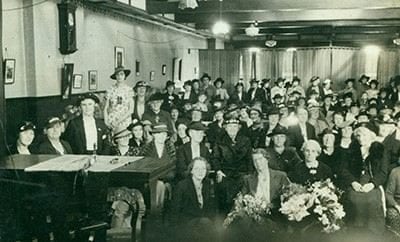
Auckland women in September 1940 marking the 47th anniversary of women’s suffrage. Emily Gibson Scrapbook. MSS & Archives 2014/9. Special Collections, University of Auckland Libraries and Learning Services.
New Zealand women had the opportunity to exercise their political power in a general election just ten weeks after winning the right to vote on 19 September 1893.
The short timeframe caused some consternation in Parliament, despite enrolment forms being available from Registrars and at all Post Offices. Questions about the practicalities involved were immediately raised in the House. Would women have time to enrol? Would their enrolments be processed in time? Would additional clerical staff be required? Suggestions that police should go from house to house to enrol women and that the election should be delayed were both dismissed.1
The Auckland Women’s Franchise League (AWFL), which had been instrumental in getting Auckland women to sign the suffrage petition, now focused their energy on getting women enrolled to vote. They led by example, with League president Mrs Amey Daldy among the first seven women in Auckland to sign up.2 The AWFL arranged for enrolment forms to be available at businesses in Ponsonby, Karangahape Rd and Hobson Street3 and held public meetings to explain the enrolment process and voting procedures.4 At a meeting in the Foresters’ Hall, Newton on 22 September, Daldy advised women to ‘look with suspicion on those who canvassed them for votes’ and to be sure to vote for ‘candidates whom they considered of honourable principles, and who would do their best to bring good laws into force and do away with bad ones.’5
The work of organisations like AWFL, whose minute books are held by Special Collections, meant that 109,461 women or about 84 percent of the adult female population enrolled to vote in the election on 28 November 1893. On polling day, 82 percent of enrolled women cast their votes.6
Among the first Auckland women voters was AWFL member Emily Patricia Gibson (1863-1947).7 A proof-reader and compositor at the Auckland Star, Gibson voted at the Army Hall in Rutland Street, where she and other women were jeered by male voters. Gibson recalls that ‘We were brave because we were together but not one of us was not trembling and trying to hold back tears.’8 Voting at other Auckland polling booths went relatively smoothly with women arriving early and displaying, as one newspaper condescendingly put it, ‘an unexpected smartness in picking up the method of voting.’9
The photo above from Gibson’s scrapbook shows past AWFL members and their daughters gathered in September 1940 to mark the 47th anniversary of women’s suffrage.10 Gibson is seated in the front row, far right.
Katherine Pawley, Special Collections
References
1 Woman Suffrage: complete victory. (1893, September 20). New Zealand Herald, p.5.
2 The first seven women in Auckland to enrol were reported as: Mrs Elizabeth Baxter, Mrs Annie Ward, Mrs Matilda Allsop, Mrs Hannah Adams, Mrs Annie Dewar Owen and Mrs A. Daldy. The enfranchisement of women: enrolling the new electors. (1893, September 21). New Zealand Herald, p.5.
3 ibid.
4 The evening meeting: speeches and resolutions, advice to the women. (1893, September 23). Auckland Star, p.2.
5 ibid.
6 Ministry for Culture and Heritage. (2018). Women vote in first general election. Retrieved from https://nzhistory.govt.nz/page/women-vote-first-general-election
7 Women’s suffrage anniversary luncheon: first voter in Auckland. (1940, September 20). New Zealand Herald, p.11.
8 Hutching, M. (2018). Gibson, Emily Patricia, Dictionary of New Zealand Biography. Retrieved from https://teara.govt.nz/en/biographies/3g7/gibson-emily-patricia
9 The polls during the day. (1893, November 28). Auckland Star, p.5.
10 Emily Gibson Scrapbook, 1936-1947. MSS & Archives 2014/9. Special Collections, University of Auckland Libraries and Learning Services.
